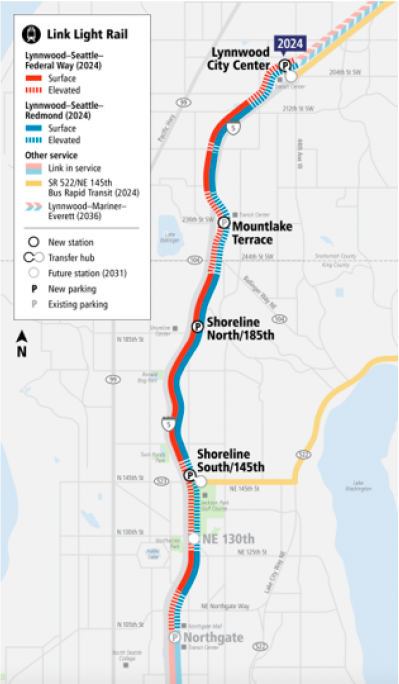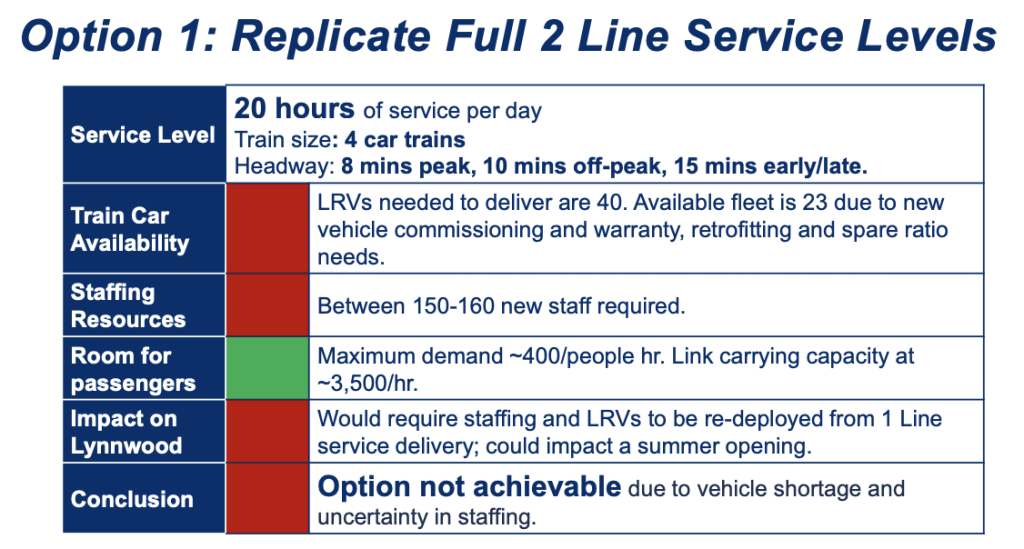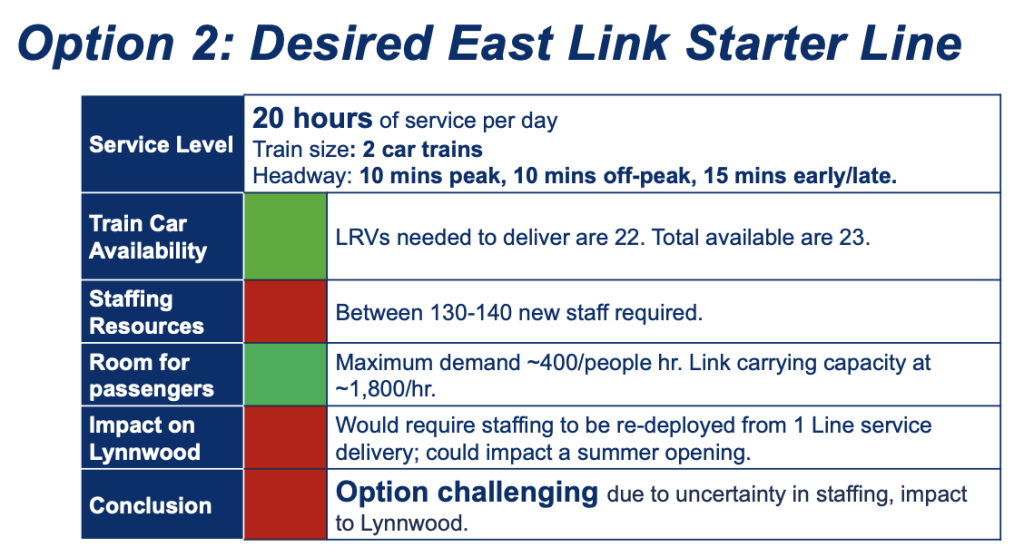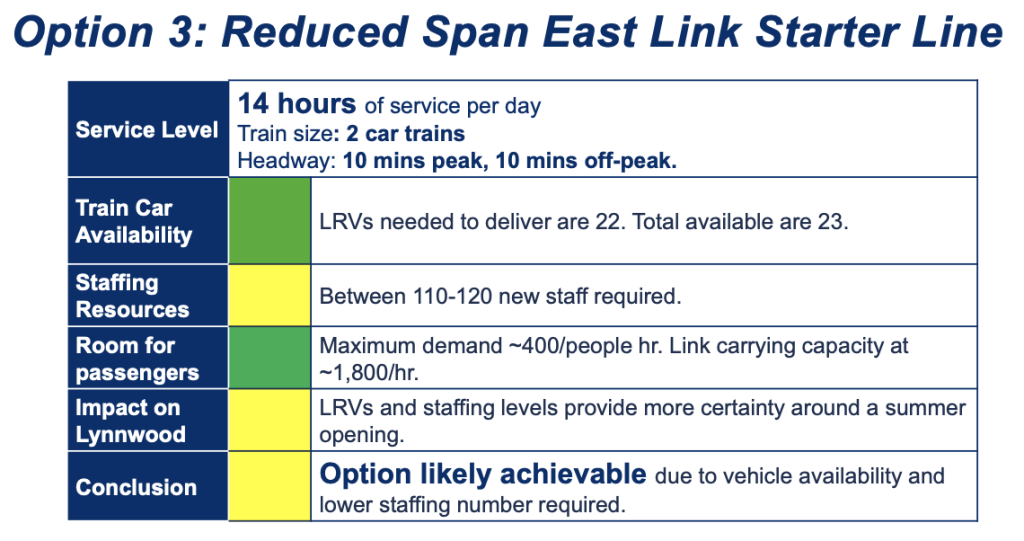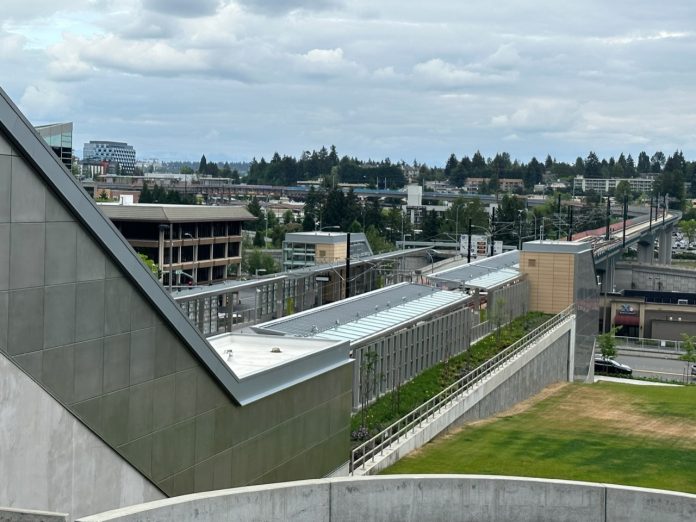
Lynnwood Link will operate at reduced frequencies, as would an Eastside-only East Link starter line.
Sound Transit shared its early service plan concepts for 2024 earlier this month. By and large, those concepts are complicated by operations staffing shortages and Link expansion delays and constraints. The agency, however, is planning to make some service adjustments next year to coincide and support Link expansion where feasible and sensible.
Lynnwood Link Extension service concepts
Sound Transit expects to open the Lynnwood Link Extension in the summer or fall of 2024. But that extension won’t initially be supported by the added train capacity added by the East Link (2 Line) extension as originally anticipated. Without benefit of a second line and extra storage capacity at the Operations and Maintenance Facility East in Bellevue, the agency won’t be able to provide combined service frequency of every four minutes at peak, five minutes midday, and eight minutes in the evenings — all with four-car trains.
In response to constraints, the agency is only planning to run the 1 Line on the Lynnwood Link Extension at reduced frequencies initially. Storage capacity shortfalls will likely mean further reducing service levels on the 1 Line in the form of less frequent trains, shorter trains, altered corridor service, or a mixture of those strategies. Currently, service operates every eight minutes during peak hours, 10 minutes during off-peak hours, and 12 to 15 minutes during early morning and late night hours with a mix of three- and four-car trains.
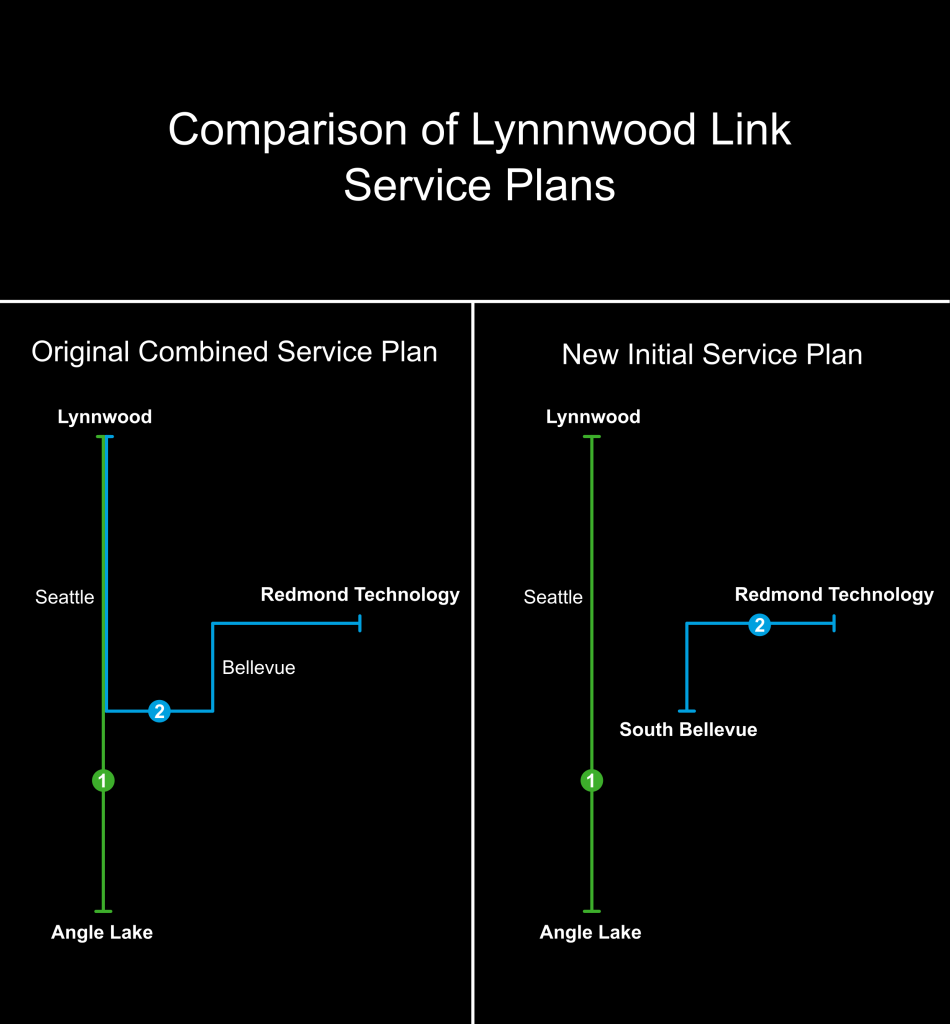
Decisions on what the Lynnwood Link operational structure and service levels should come later this year.
With reduced service to Lynnwood, models are showing that there will be crowding issues on Link mainly on the segment between Westlake and Northgate Stations, agency service planner Brian de Place said.
“We are determining the feasibility of providing bus shuttle service to mitigate the crowding as well as restoring the two remaining Sounder North trips that were stood down during the Covid pandemic,” de Place told boardmembers at the Sound Transit Rider Experience and Operations Committee this month. The agency believes that could relieve some pressure on Link and I-5 bus service.
Changes planned for bus service around the Lynnwood Link Extension will affect I-5 ST Express bus service. Routes 512 (Everett-Northgate) and 513 (Seaway Transit Center-Northgate) will be shortened to terminate at Lynnwood, saving substantial service hours that could be reinvested into service on the routes. Route 510 (Everett-Northgate Express) and suspended Route 511 (Ash Way Transit Center-Northgate) will also be eliminated, allowing their service hours to be redeployed. However, service planners are proposing to delay revisions to Route 522.
Route 522 currently terminates at Roosevelt Station, providing Lake City, Lake Forest Park, Kenmore, and Bothell a direct connection to Link. The agency had planned to reroute the southern tail to serve Shoreline South/148th Station four miles to the north, but that was predicated upon connecting to a station with much higher levels of train service from both the 1 and 2 Lines. Without both lines serving the station and the benefit of substantive local bus service, running Route 522 to the station could result in a poor rider experience. Modifying the route would mean abandoning a large portion of service on Lake City Way, especially if King County Metro’s austerity-minded Lynnwood Link bus restructure comes to pass.
Looking further ahead, de Place flagged another service issue that Sound Transit may face even when the 2 Line is fully operational.
“We have performed an operational analysis of the Lynnwood terminus and it shows that there may be challenges reliably delivering combined four-minute headways when the 2 Line does cross the lake,” de Place said. The headway issue essentially boils down to getting trains cleared of riders, quickly cleaning them, and then turning them back into service.
East Link Extension service concepts
Since the I-90 construction issues will take some time yet to fully address, Sound Transit is pursuing the study of a shorter East Link starter line from South Bellevue to Redmond Technology Center Stations. Service levels initially would be notably lower than original plans for a full 2 Line service to Lynnwood Station with corresponding bus-to-Link restructures.
Without the full line service and benefit of tailored connecting bus service, agency service planners are projecting average daily ridership on the 2 Line to reach up to 6,700, depending upon the service scenario. Three different service scenarios for the East Link starter line have been evaluated. In broad strokes, this is how they differ:
- Option 1 would provide 20 hours of service per day using four-car trains. Headways would be every eight minutes during peak hours, 10 minutes during off-peak hours, and 15 minutes during early morning and late night hours. Vehicle and staffing requirements, however, would exceed what the agency could reasonably provide to operate the service option.
- Option 2 would provide 20 hours of service per day using two-car trains. Headways would be every 10 minutes during peak and off-peak hours, and every 15 minutes during early morning and late night hours. Staffing requirements, however, would exceed what the agency could reasonably provide to operate the service option.
- Option 3 would provide 14 hours of service per day using two-car trains. Headways would be every 10 minutes during peak and off-peak hours, and every 15 minutes during early morning and late night hours. The agency believes that this option could have sufficient vehicles and possibly enough staff to reliably operate it.
Rider Experience and Operations Committee Chair Kristina Walker asked if there was any other “middle ground” scenarios studied that offered 16 or 18 hours of service. George McGinn, another agency service planner, said that going above 14 hours may require three shifts of staff, but agency will look at what the impacts would be by adding the extra service hours.
Given hiring trends, McGinn said that a target of 110 to 120 new operations and maintenance staff for the starter line seemed feasible and would support two staffing shifts. The third option is also comparatively attractive because it would be less likely to impact Lynnwood Link resources and only miss a small number of potential riders (about 15%).
Separately, King County Councilmember Claudia Balducci has asked staff to look at alternative operational approaches, such as using one-car trains and providing span of service that is similar to the 1 Line. Her concern is that running service over a shorter period of day may be confusing to riders, but she also wants to be sensitive to the Lynnwood Link Extension by not over-stressing resources. Balducci has also expressed support for examining an earlier opening of the Lynnwood Link Extension, if its completion is trending early and the Downtown Redmond Link Extension is trending earlier. She’s contemplating a sequencing of two openings in that scenario with Lynnwood Link first and then a wider opening of the East Link starter line all the way to Downtown Redmond.
Until the 2 Line is able to provide cross-lake service, agency service planners are recommending that Eastside ST Express bus service remain unchanged. Without a fully activated line, travel times could increase by 10 or more minutes for about 2,500 weekday ST Express bus riders. A premature bus restructure would also introduce service gaps.
Other service change concepts and next steps
While the agency would like to restore service and implement substantive improvements to its ST Express bus network, staffing levels for transit operators and maintenance staff remain a big impediment. Sound Transit relies on King County Metro, Community Transit, and Pierce Transit to operate ST Express bus service. Only the latter two have been successful in halting the exodus of staffing while Metro continues to see its staffing levels evaporate and has struggled to halt the trend. Compounding this problem, Sound Transit staff have also cited supply chain issues slowing parts replacement on vehicles, keeping them out of service for longer time periods. As a result, Sound Transit service planners expect no ST Express service increases in 2024.
Something that the agency is evaluating, however, is how to make resource-neutral modifications to service in Pierce County and South King County. “For instance, if we were to combine certain route patterns in the south corridor, we could potentially deliver more frequency in that corridor but it would add to overall travel times,” de Place said. “If we find this to be a viable concept, we will be soliciting rider input later this summer.”
Throughout the late spring and summer, Sound Transit will be soliciting public feedback on service plan elements, such as Lynnwood Link and its bus restructure, East Link starter line service, and some ST Express bus service concepts. Then in the fall, the agency will recommend a service plan for adoption by the agency board.
Stephen is a professional urban planner in Puget Sound with a passion for sustainable, livable, and diverse cities. He is especially interested in how policies, regulations, and programs can promote positive outcomes for communities. With stints in great cities like Bellingham and Cork, Stephen currently lives in Seattle. He primarily covers land use and transportation issues and has been with The Urbanist since 2014.


